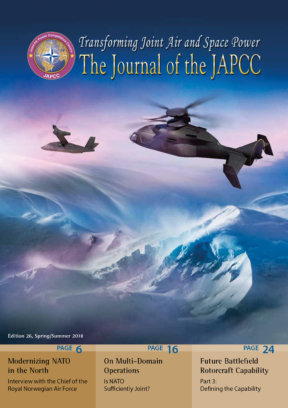Introduction
After the International Security Assistance Force (ISAF) mission and Operation Enduring Freedom (OEF) in Afghanistan, many of the Tactics, Techniques, and Procedures (TTP), as well as Lessons Learned/Lessons Identified (LL/LI) evolved within permissive air environments. Indeed, in the past 20 years, the vast majority of NATO operations involving air power have enjoyed Air Superiority or, in some cases, even Supremacy. Because of this, NATO’s Close Air Support (CAS) and Joint Terminal Attack Controller (JTAC) capabilities have matured along these lines.
However, within the last four years the strategic geopolitical scenario has rapidly and dramatically evolved with the re-emergence of near-peer adversaries. This shift includes a growing hybrid-warfare paradigm and emerging Anti-Access/Area Denial (A2/AD) environments. Tellingly, the 2014 Wales1 and 2016 Warsaw2 NATO Summits highlighted various shortfalls within the Alliance such as CAS and Precision Guided Munitions (PGMs).
CAS evolution has always been dependent on technological developments, and it will undoubtedly continue to evolve as technology improves. However, how all three Services will carry out Close Support to ground forces will require solutions and methods that are more than mere technological improvements. So, what is the role of Close Air Support in the future battle and does it still hold a place in an ever more complex scenario, within a contested environment, and projected against a peer or near-peer adversary? And is ‘Air’ the only way Close Support will be delivered?
Driving Factors
Air Superiority/Supremacy has not been a major concern for NATO Air Power in Kosovo, Iraq, or more particularly, in Libya and Afghanistan. Ground forces had a psychological benefit in knowing that a persistent presence in the sky was ready to ‘immediately’ intervene if needed. When troops became engaged (‘in contact’) with the enemy, a competent Tactical Operating Centre (TOC) alerted the Air Component for the necessity of CAS. Most of the time an asset was already available in the air nearby, or just above, those troops.
Nonetheless, the international political strategic environment has changed rapidly in the past four to five years, accompanied by ‘new’ emerging threats. Terms such as ‘Hybrid’, ‘Asymmetric’ and ‘Urban warfare’, as well as ‘A2AD Environment’ have saturated various think papers, studies, and articles from various international agencies and services to describe the new climate. At the same time countries within the Alliance have had to struggle with budget cuts which affected their national defence capabilities and contributions to collective defence. In effect, NATO is faced with new realities and challenges, most of which involve highly contested operations. As reflected in the outcome of the 2014 and 2016 Summits, the Alliance has had to admit that something has to change, in regards to funding and capabilities, so as not to be found unprepared for the next potential battle.
Developing and implementing improved CAS technology is one effort that may enable preparation for this future battlespace. However, the evolution of technology within the CAS community has been inconsistent at best and the introduction of new CAS technologies have not been without difficulties. The challenge of providing reliability and accuracy in environmentally austere environments has often given rise to scepticism and resistance to new ways of providing CAS. In general, changes to operating procedures are not always accepted and implemented without pain by the Services throughout the Alliance, where tried and true tools such as the consolidated ‘nine-liner’3 are well-known, and therefore psychologically palatable to soldiers and airmen. On the other hand, it is clear that modern systems evolution can help streamline CAS processes and produce better results.
Additionally, the Alliance must make better use of its current training capabilities to continue to provide robust CAS training. ‘Live’ flying hours are very costly and are becoming increasingly scarce in the context of shrinking conventional force structure. Real life assets are increasingly less available for training due to two main factors: first, most available CAS assets are already employed in operations and second, a lot of CAS aircraft and equipment are reaching their end of service life without timely replacement. Therefore, the use of training tools such as simulators and other high tech equipment is imperative to prepare our aircrews and troops for future contingencies. Indeed, any resistance to innovation has to be put aside. Practically speaking, nations cannot afford to carry out training without CAS simulators and pooling and sharing of resources. Of particular note is the need to conduct training sessions with partners by networking their facilities and making them available to others within the Alliance. Only by sharing resources and training will we be prepared for the next fight.
Finally, the decreasing availability of pure CAS air assets not only affects training, but is being felt in decreased operational capability as well. For this reason, absent a large aircraft recapitalization effort across the Alliance, it is apparent that other joint capabilities are going to need to be integrated into close tactical support of ground troops. Perhaps it is time to consider shifting our paradigm from Close Air Support to Close Joint Support.
The Promise (and Problem) of Future CAS
At present, one of the leading concerns of the CAS community is the transformation of CAS provided primarily by 4th generation aircraft to CAS delivered by 5th generation air assets (and future 6th generation). While similar paradigm shifts occurred when NATO transitioned from 2nd to 3rd to 4th generation aircraft and with the advent of the data-link, the introduction of 5th generation aircraft, combined with technological advances and shrinking conventional inventories, may catalyse brewing changes to CAS information and Command and Control (C2) nodes.
It is evident that the introduction of 5th generation assets into operational service is going to shift the ‘modus operandi’ at the tactical and operational levels and will provide new opportunities to the command chain. For example, due to fewer tactical fixed-wing aircraft but increased data sharing among more capable platforms the use of Forward Air Controllers-Airborne (FAC/A), Unmanned Air Systems (UAS) and Airborne Battlefield Command and Control Centre (ABCCC) in Close Support will likely be more active, useful and necessary. Consequently, there will be a need to better define this evolving paradigm in publications and TTPs.
Rotary Wing will also play a vital role in the future CAS battle, especially when it comes to urban environments. The increasingly urban nature of warfare is creating a problem-set unlike much that the Alliance has faced over the last 25 years. In this environment, it will be necessary to have high mobility and manoeuvrability, plus robust communications relays.
This future environment will likely include a robust and resilient C2 ‘net’, capable of supporting CAS enablers such as Digitally Aided CAS (DaCAS)4. DaCAS promises to enable crews/JTACs to link systems and weapons to ease and speed up CAS processes to have a better understanding of the battlespace and improved results with fewer steps. However, it has to be emphasized that not all Nations will acquire such technology in the near future and therefore there likely will be a capability gap. It will be imperative to strive towards a common picture and investment implying collective, multi-level (cross-Service and cross-Nation) will, an ability to trust one another, share data and prioritize operations in accordance with the available assets. A cohesion that transcends and elevates past the purely Military sphere.
Future Weapons/CAS Enablers
Of interest to various military communities, including the CAS community, are ongoing developments in the field of advanced weaponry; for example, in the fielding and perfecting of hypersonic projectiles fired by ‘Railguns’. Railguns are devices that use electromagnetic force to launch projectiles with velocities in excess of Mach 5, using a sliding armature that is accelerated along a pair of conductive rails. Normally, the projectile does not contain explosives but relies on speed-related kinetic energy to inflict damage. The absence of explosive propellants or warheads to store and handle, as well as the low cost of projectiles compared to conventional weaponry, gives an advantage to the handler of the weapon. The speed, range and responsiveness of the weapon could prove key to providing future Joint ‘close’ fires, especially in contested areas that are difficult for aircraft to reach.
Furthermore, studies continue into the introduction and growth of Network Enabled Munitions (such as already existing SDB II Small Diameter Bombs) which can be reprogrammed in flight, hence giving more flexibility and prioritization in real time. Similarly, there are already some programs in the US for munitions which will fly in swarms. In the near future, there will be the introduction in service of Directed Energy Weapons (DEWs). These systems use DE primarily as a direct means to damage or destroy adversary equipment, facilities, and personnel through the emission of highly focused energy.
The Need for ‘Jointness’
In certain environments (with a non-near-peer adversary) current concepts of ‘permissive environment CAS’ could still apply. However, against a near-peer opponent in a heavily contested environment, the contemporary approach to CAS will need adjusting.
In a highly contested A2AD scenario, presence and/or persistence of air assets will not necessarily be allowed. Traditional CAS assets with long loiter times and large ordnance capacities, but relatively low airspeeds and limited defensive systems, may not survive in such environments. Conceptually, much of the air effort will be directed against opponent fighter waves, enemy C2 facilities and surface-based Air Defence installations.
In this environment, multiple, simultaneous Troops in Contact (TICs) will be daily occurrences. If the ‘A2/AD’ environment is challenging enough, very few legacy aircraft will be able to support these TICs directly. This will dictate a priority of intervention and force Services to use all of the assets at their disposal. In other words, the required support will arrive by various methods and means, not all of which will be from the air component (e.g. naval and artillery fires). While this is not a new concept, the range and precision of Joint fires have increased dramatically over the last two decades. Coupled with increased/robust targeting information from new and improved sources (e.g. F-35), the reality of transforming the way we deliver fire support to engaged ground forces is within our grasp.
Conclusions, Recommendations and Possible Solutions
AJP-3.3.2.1 and ATP-63 define Close Air Support as: ‘air action against hostile targets which are in close proximity to friendly forces and which require detailed integration of each air mission with the fire and movement of those forces.’
In fact, the characterization of the future battlespace begs intriguing questions within the CAS community:
- Is the Term ‘Air’ still totally adequate in the CAS name and definition? (I.E. does the ‘Air’ only imply support delivered by aircraft?)
- Should an ‘Air only’ concept evolve to a cross-Service/Domain vision? (E.G. with Joint fires/indirect fire)
Today’s equipment, assets, TTPs and Training have to evolve and become standardized across the Alliance to face the technological and conceptual changes of the future. This is because resources are fewer in numbers and more expensive and their use has to be optimized for a better result. So, in a slight deviation from the classic saying, ‘Train as you will fight and fight as you have trained.’
The components have to accept the fact that the Close Support mindset has to radically change from an air-only intervention to a cross-service/multi-domain concept (eventually to ‘All Domain’) to counter the future challenges in the modern battlefield. Evolved threats will not allow our crews to operate in total freedom as they used to. Because it will still be imperative to provide Close Support where and when it is needed as fast and as accurate as possible, a drastic change in doctrine and CAS TTPs will be required. Not only must we teach our personnel the importance of joint thinking, we must also institutionally change how we train and operate together. It goes without saying that such a radical change will have epochal consequences and implications on the C2 environment.5
Ultimately, it is inescapable that the future battle should transform from a cacophonic mesh of single service fights, with a marginal consideration for sister components, to a unified, truly joint fight.
Author’s Note: The JAPCC is in the process of publishing a study which will further outline a vision of the future of CAS which will draw from previous lessons from other JAPCC studies but including the concept of Alliance assets as a system of systems. The study, among other things, will explore the ideas of transforming Close Air Support to Close Joint Support and shifting from close control of specified assets to an effect-based request system within a Joint effort.













